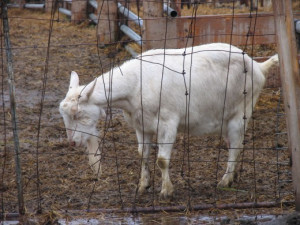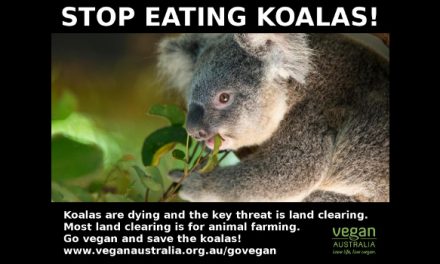Written by There’s an Elephant in the Room Blog
I’ve just been watching a mainstream TV program in the UK about ‘meat free eating’. As a blogger and an animal rights advocate I’ve written extensively about the difference between veganism and the various dietary permutations that are adopted so often by decent people who sincerely want to stop hurting and killing members of other species because they have begun to realise it’s not necessary to harm any creature for us to be healthy.
Very often we adopt these dietary permutations because the available information about them is extremely misleading. There are many reasons for this, that I won’t go into in this post (but which you may find by exploring my site) except to stress the primary underlying factor. Those who profit from creating victims for nonvegans are making so much money from doing it that they really don’t want you to stop and your confusion is greatly appreciated by them. As far as they’re concerned, they would love for you to stay completely bewildered – in the same way that I was for years.
However tonight – let me share one clarifying piece of information. The recipe I’ve just watched on this programme that I mentioned contains a vast quantity of butter (easily substituted by nondairy alternatives) and a big wedge of cheese – ‘parmesan’ as a matter of fact. There was a passing reference made to the fact that ‘vegetarian’ cheese is available, but as usual, it was passed off as inconsequential. So here’s a thing. How many nonvegans know the difference between 1) the kind of cheese we were all raised to think of as ‘normal’, 2) vegetarian cheese and 3) vegan cheese?
The differences between these are anything but trivial from the perspective of the defenceless creatures who are paying with absolutely everything they have for our careless indulgence.
1) The kind of cheese we were all raised to think of as ‘normal’
This is made from the breast milk of mother mammals. These may be cows, goats or ewes, buffalo or camels, we have no scruples and no restraint as a species. These mother mammals were forcibly impregnated for the sole purpose of triggering lactation (breast milk production) and very shortly after their infants were born, often still wet from the womb, they were taken away so that the mothers’ breastmilk could be sold to humans.
The ‘traditional’ manufacture of cheese requires an acidic substance to curdle that breast milk and in the case of what most of us were raised to consider ‘normal’, this curdling agent is called ‘rennet’. So far so good. Show of hands for who knows what ‘rennet’ is?
Rennet is a substance made by the stomach of an infant mammal; a calf, a kid, a lamb, that forms part of the process of digesting the breastmilk of his or her mother. For cheese production, it is obtained by slaughtering the newborn and extracting the substance from their stomach.
So just to recap, for ‘traditional’ cheese, we have a forcibly impregnated mother mammal, her newborn who has been separated from her so her breastmilk can be sold to humans for profit, the same distraught and terrified infant whose throat was hacked open in a slaughterhouse so that their infant stomach can be cut open to extract the rennet so that humans can make ‘cheese’. I doubt if that’s the way most people think of it, but these are the facts. Check them out – this is the age of Google. I wouldn’t be surprised if some people find that idea somewhat revolting, so surely the ‘vegetarian’ option may seem more appealing?
2) Vegetarian cheese
This is made from the breast milk of mother mammals. These may be cows, goats or ewes, buffalo or camels, we have no scruples and no restraint as a species. These mother mammals were forcibly impregnated for the sole purpose of triggering lactation (breast milk production) and very shortly after their infants were born, often still wet from the womb, they were taken away so that the mothers’ breastmilk could be sold to humans. No difference so far.
The ‘traditional’ manufacture of cheese requires an acidic substance to curdle that breast milk and in the case of ‘vegetarian’ cheese, that substance is derived from a source other than the stomach of a slaughtered infant. There are several plants, types of molds, fungus, and bacteria that have natural coagulation qualities and can be used in place of animal rennet to make cheese. In researching the details for this post, I found that GM nonhuman DNA is now sometimes added to some of these options so the resulting substance more closely resembles ‘traditional’ cheese. I read that ‘no animals are harmed this way’, which rather emphasises my point about misleading information.
To recap, for ‘vegetarian’ cheese, we have a forcibly impregnated mother mammal, her newborn who has been separated from her so her breastmilk can be sold to humans for profit, the same distraught and terrified child whose throat was hacked open in a slaughterhouse. The minor difference in the manufacture of the ‘vegetarian’ cheese did not save the infant from being taken from his or her mother, did not save them from death, but may have postponed the terrifying slaughter until their body was sufficiently grown for their dead flesh to generate more profit for the victim makers and butchers.
I can only wonder whether the ‘vegetarian’ option sounds so good now?
3) Vegan cheese
Vegan cheese is made from plant substances that closely resemble ‘traditional’ cheese and ‘vegetarian’ cheese in both taste and texture. No innocent members of other animal species are harmed in its manufacture, and the available range of such cheeses expands every day and is obtainable in every supermarket. What more do I need to say?
By paying for harm and the death of innocents, we ensure that it will continue to make profit for those without scruples who make money from our ignorance. Is that really who we are? Be vegan.



